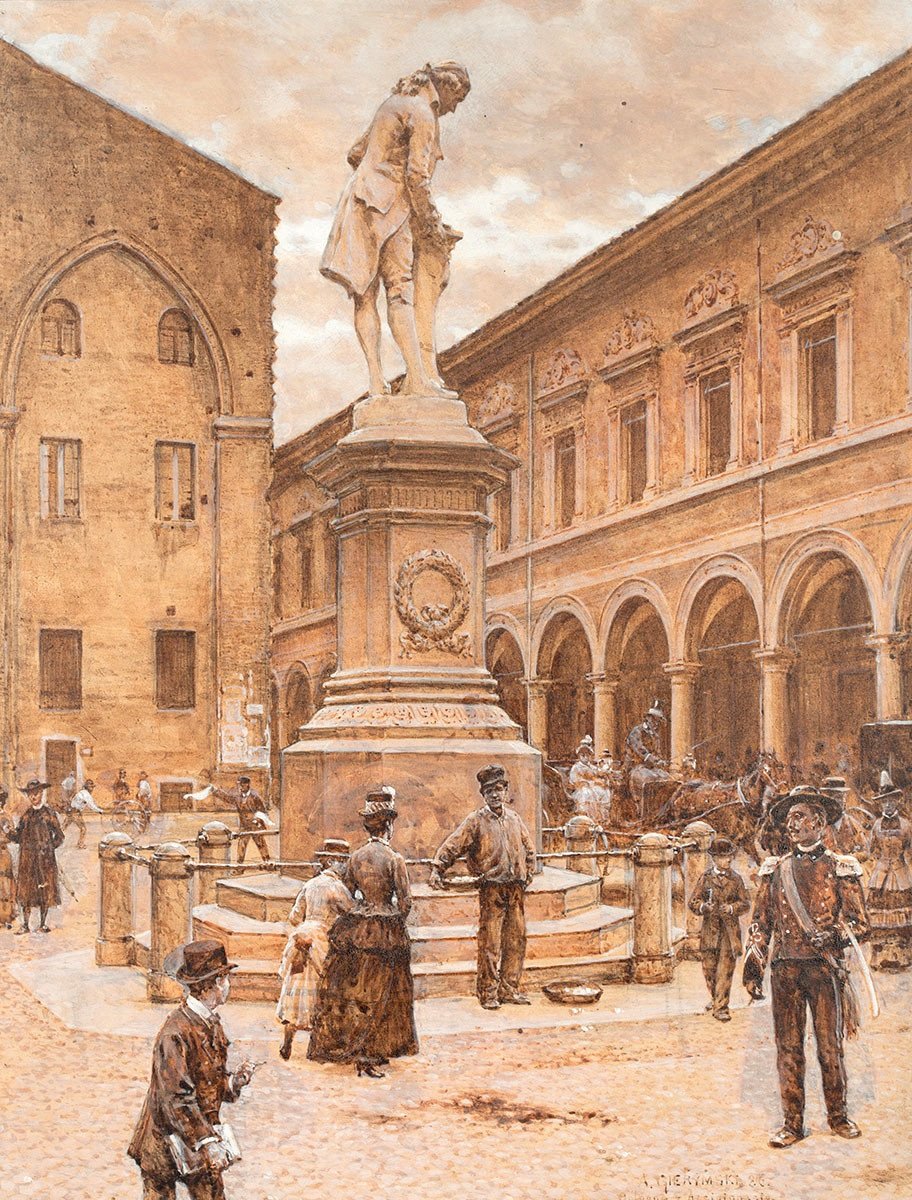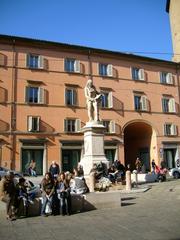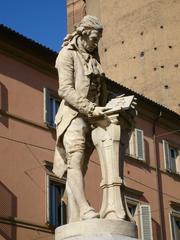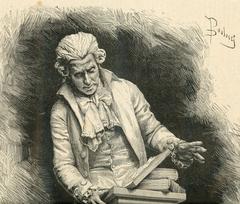
Visiting the Monument to Luigi Galvani in Bologna, Italy: Complete Guide with Tickets, Hours, and Tips
Date: 14/06/2025
Introduction
Nestled in the vibrant heart of Bologna, the Monument to Luigi Galvani stands as an enduring tribute to one of the city’s most celebrated scientific pioneers. Luigi Galvani (1737–1798) is renowned for his discovery of bioelectricity, a breakthrough that laid the foundations for electrophysiology and influenced science and culture worldwide. This comprehensive guide details how to visit the monument, including essential information on hours, accessibility, ticketing, and nearby attractions, while also exploring the monument’s artistic significance and role in Bologna’s civic identity.
For further exploration, consult resources like the Museo di Palazzo Poggi, the Bologna Tourism Official Website, and historical background on IGotoWorld.
Table of Contents
- Introduction
- About the Luigi Galvani Monument
- Historical Context and Significance
- Creation and Artistic Features
- Visiting Hours and Ticket Information
- Accessibility
- Practical Visitor Tips
- Guided Tours and Educational Opportunities
- Nearby Attractions
- Events and Local Atmosphere
- Accommodation Options
- Connectivity and Further Exploration
- Local Etiquette and Cultural Insights
- Frequently Asked Questions (FAQ)
- Visuals and Media
- Summary and Final Recommendations
- References
About the Luigi Galvani Monument
Located in Piazza Galvani, directly in front of the Archiginnasio, the monument was unveiled in 1879 and was sculpted by Adalberto Cencetti. The statue captures Galvani immersed in his scientific studies, symbolizing Bologna’s strong intellectual heritage and its tradition of honoring scientific achievement (IGotoWorld).
Historical Context and Significance
Luigi Galvani: The Scientist
Galvani, a physician and professor at the University of Bologna, is celebrated for pioneering research in bioelectricity. His experiments demonstrating that frog legs twitched in response to electrical sparks revolutionized medicine and biology, introducing the term “galvanism.” His influence extends culturally, inspiring works such as Mary Shelley’s Frankenstein and contributing to scientific debates with contemporaries like Alessandro Volta (IGotoWorld; Paul’s Bologna Blog).
Piazza Galvani
The monument’s setting, Piazza Galvani, is a historic square that once hosted a silk market and now serves as a bustling civic space, bordered by the Basilica of San Petronio and the Archiginnasio Library (Bologna Welcome).
Creation and Artistic Features
Artistic Competition and Realization
After Italian unification, citizens rallied to honor Galvani with a monument, leading to a public subscription and an artistic competition. Adalberto Cencetti was ultimately selected to sculpt the statue, despite controversy over local artists being overlooked (Storia e Memoria di Bologna).
Design and Symbolism
Crafted from white marble, the monument stands on a high plinth adorned with a bronze laurel wreath and scepter—symbols of scholarly achievement. Galvani is depicted in a dynamic pose, bending over a table with books and a plate holding a frog, referencing his bioelectricity experiments. These artistic choices emphasize his intellectual rigor and the spirit of scientific inquiry (IGotoWorld; Evendo).
The statue’s lifelike realism was praised at its inauguration and set a precedent for later civic monuments in Bologna (Storia e Memoria di Bologna).
Visiting Hours and Ticket Information
The Luigi Galvani Monument is an outdoor public sculpture, accessible 24 hours a day, seven days a week. There is no admission fee or ticket required to visit the monument itself.
For those interested in Galvani’s academic environment, the nearby Museo di Palazzo Poggi features anatomical exhibits related to his work. The museum is open Tuesday to Sunday, 9:00 AM–7:00 PM (last entry at 6:00 PM), with tickets around €6 for adults and discounts for students and children (Museo di Palazzo Poggi).
Accessibility
Piazza Galvani is wheelchair accessible, with flat pavements, ramps, and nearby public transportation. The Museo di Palazzo Poggi also offers accessible services, including elevators and adapted restrooms. For specific needs, it is advisable to contact the museum in advance.
Practical Visitor Tips
- Best Times: Early mornings or late afternoons provide ideal lighting and fewer crowds for photography.
- Weather: Bologna’s covered porticoes offer shelter year-round, but consider visiting in spring or early autumn for pleasant temperatures.
- Footwear: Wear comfortable shoes, as the historic center’s cobbled streets are best explored on foot (The Travel Folk).
- Restrooms: Public facilities are available inside the Archiginnasio during opening hours.
- Safety: The square is safe and lively, but remain mindful of personal belongings in crowded areas.
Guided Tours and Educational Opportunities
While there are no dedicated tours of the monument alone, it features on many self-guided and organized walking tours of Bologna’s historic center. Local guides offer in-depth context on Galvani’s achievements and the monument’s significance (Nomads Travel Guide; Walk Tour Bologna).
The monument is also used during educational events and public ceremonies, especially around anniversaries of Galvani’s birth and scientific milestones.
Nearby Attractions
- Archiginnasio Palace: Historic university building with the renowned Anatomical Theatre and Stabat Mater Hall, open Monday–Saturday, 10:00 AM–6:00 PM (admission €3).
- Piazza Maggiore: Main square, home to the Basilica di San Petronio and Palazzo d’Accursio.
- Quadrilatero Market District: A maze of food stalls and specialty shops, ideal for sampling Bolognese cuisine.
- Basilica di San Domenico: Houses the tomb of Saint Dominic and works by Michelangelo.
- Palazzo Galvani: Home to the Museo Civico Archeologico with Etruscan, Roman, and Egyptian collections (Arte.it).
- Due Torri (Two Towers): Iconic medieval towers offering panoramic city views.
- Porticoes of Bologna: UNESCO-listed arcades sheltering much of the city center (The Travel Folk).
Events and Local Atmosphere
Piazza Galvani is a lively gathering place, regularly hosting open-air concerts, cultural events, and seasonal festivals, especially in the summer months. For up-to-date event listings, check the Bologna Tourism Official Website and All Events in Bologna.
Accommodation Options
Recommended nearby hotels include:
- Grand Hotel Majestic già Baglioni: Luxury, classic elegance.
- Hotel Touring: Stylish mid-range.
- Albergo Centrale: Budget-friendly, central location (Nomads Travel Guide).
Connectivity and Further Exploration
Piazza Galvani is a convenient starting point for walking tours. Bologna Centrale train station is a 15-minute walk away, and the city’s layout allows easy access to most major sights on foot or by public transportation (The Travel Folk).
Local Etiquette and Cultural Insights
Bolognese residents are known for hospitality. Respect the space by speaking quietly and being considerate during events or religious processions. Photography is welcome, but be mindful of other visitors.
Frequently Asked Questions (FAQ)
Q: What are the visiting hours for the Luigi Galvani Monument?
A: The monument is accessible 24/7 as a free outdoor sculpture.
Q: Do I need a ticket to visit?
A: No, there is no admission fee or ticket required.
Q: Are guided tours available?
A: While no tours focus solely on the monument, many walking tours of Bologna include it as a stop.
Q: Is the monument accessible for people with disabilities?
A: Yes, Piazza Galvani is wheelchair accessible and features smooth pavements.
Q: What are the best times to visit?
A: Early mornings or late afternoons for a quieter experience and better light.
Visuals and Media
Explore the location on Google Maps
Alt text for images: “Monument to Luigi Galvani in Piazza Galvani, Bologna” and “Archiginnasio Palace in Bologna.”
Summary and Final Recommendations
The Monument to Luigi Galvani epitomizes Bologna’s legacy of scientific innovation and civic pride. Open to the public 24/7 with no entry fee, it provides an accessible and meaningful experience for all visitors. Surrounded by historic sites, vibrant markets, and renowned architecture, the monument is both a cultural landmark and a perfect starting point for exploring Bologna’s rich heritage.
To enhance your visit, consult the Audiala app for guided tour options, and refer to resources like Paul’s Bologna Blog and Walk Tour Bologna for insider tips and updated information. Embrace the unique blend of history, art, and science that defines Bologna—and discover the lasting impact of Luigi Galvani.
References
- Museo di Palazzo Poggi
- IGotoWorld
- Paul’s Bologna Blog
- Nomads Travel Guide
- Walk Tour Bologna
- The Travel Folk
- Bologna Welcome
- Arte.it
- All Events in Bologna
- Evendo



































